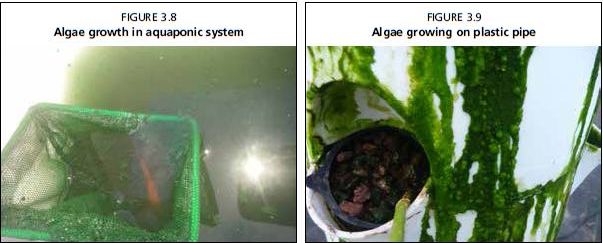3.3 OTHER MAJOR COMPONENTS OF WATER QUALITY: ALGAE AND PARASITES
3.3.1 Photosynthetic activity of algae
Photosynthetic growth and activity by algae in aquaponic units affect the water quality parameters of pH, DO, and nitrogen levels. Algae are a class of photosynthetic organisms that are similar to plants, and they will readily grow in any body of water that is rich in nutrients and exposed to sunlight. Some algae are microscopic, single-celled organisms called phytoplankton, which can colour the water green (Figure 3.8). Macroalgae are much larger, commonly forming filamentous mats attached to the bottoms and sides of tanks (Figure 3.9).
For aquaponics, it is important to prevent algae growing because they are problematic for several reasons. First, they will consume the nutrients in the water and compete with the target vegetables. In addition, algae act as both a source and sink of DO, producing oxygen during the day through photosynthesis and consuming oxygen at night during respiration. They can dramatically reduce the DO levels in water at night, so causing fish death. This production and consumption of oxygen is related to the production and consumption of carbon dioxide, which causes daily shifts in pH as carbonic acid is either removed (daytime higher water pH) from or returned (night time lower water pH) to the system.
Finally, filamentous algae can clog drains and block filters within the unit, leading to problems with water circulation. Brown filamentous algae can also grow on the roots of the hydroponic plants, especially in deep water culture, and negatively affects plant growth. However, some aquaculture operations benefit greatly from culturing algae for feed, referred to as green-water culture, including tilapia breeding, shrimp culture, and biodiesel production, but these topics are not directly related to aquaponics and are not discussed here.

FIGURE 3.8
Algae growth in aquaponic system
FIGURE 3.9 Algae growing on plastic pipe
Preventing algae is relatively easy. All water surfaces should be shaded. Shade cloth, tarps, woven palm fronds or plastic lids should be used to cover fish tanks and biofilters such that no water is in direct contact with sunlight. This will inhibit algae from blooming in the unit.
3.3.2 Parasites, bacteria and other small organisms living in the water
Aquaponics is an ecosystem comprised mainly of fish, nitrifying bacteria, and plants. However, over time, there may be many other organisms contributing to this ecosystem. Some of these organisms with be helpful, such as earthworms, and facilitate the decomposition of fish waste. Others are benign, neither helping nor harming the system, such as various crustaceans, living in the biofilters. Others are threats; parasites, pests and bacteria are impossible to avoid completely because aquaponics is not a sterile endeavour. The best management practice to prevent these small threats from becoming dangerous infestations is to grow healthy, stress-free fish and plants by ensuring highly aerobic conditions with access to all essential nutrients. In this way, the organisms can stave off infection or disease using their own healthy immune systems. Chapters 6 and 7 discuss additional management of fish and plant diseases, and Chapter 8 covers food safety and other biothreats in more detail.